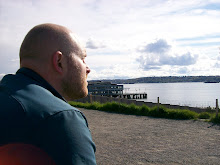looking for patterns
(warning: I did not proof this entry.)
Throughout my sabbatical I have been hoping to see patterns in culture and the church. This is how my brain works. One pattern that seems to be emerging from what I have been reading and listening to is a widespread return to local. From Omnivores Dilemma to Shop Class as Soulcraft there exists an apologetic for the economic, moral and societal good of local production. Crawford in Shop Class as Soulcraft argues that the human work experience is more fulfilling when one is involved in the tangible and holistic process of production of a good or service. It would follow then that being a very small part of a large corporation is likely less fulfilling than being part of a smaller business where real ownership can be more easily created.
As both a reaction to our vocationally mobile parents’ generation and thanks to the increasing ease of working from home there seems to be an increased desire to prioritize where we live based on relationships. This seems no more or less individualistic than the recent past, it is just that now there is the potential for us to have our cake and eat it too. There is a felt loss in my generation of knowing our neighbors and feeling a sense of community and this is felt by both those outside of and within church culture.
As another response to localization of American culture, more and more churches seem to be thinking in terms of zip codes and neighborhoods. Many small churches have always been this way and continue to be so. However larger church communities seem to be moving away from creating large campuses that create an attractive place to gather people and are now instead structuring their small and medium size gatherings by where people live. This is a significant change from people coming together because of common life stage and replacing the commonality with zip code. This trend is both influenced by the aforementioned longing to connect with people in our proximity but made easier by technology that is driving the multi-site movement. With this movement comes the ease of being part of what is emerging as core Christian orthopraxy, sustainable food consumption, greener living, less transportation costs and loving your literal neighbors.
City planning seems to be part of this greater pattern as well. I quickly leap into ignorance here but it is my understanding that more cities as they design expanding neighborhoods are looking to create walkable, self sustained neighborhoods and in doing so creating less suburban sprawl, fewer transportation issues and a greater sense of ownership in residents neighborhood.
This trend interests me the most as it relates to the church and I believe that in coming years or even months we will see the structure of the American church transform and localize.
Throughout my sabbatical I have been hoping to see patterns in culture and the church. This is how my brain works. One pattern that seems to be emerging from what I have been reading and listening to is a widespread return to local. From Omnivores Dilemma to Shop Class as Soulcraft there exists an apologetic for the economic, moral and societal good of local production. Crawford in Shop Class as Soulcraft argues that the human work experience is more fulfilling when one is involved in the tangible and holistic process of production of a good or service. It would follow then that being a very small part of a large corporation is likely less fulfilling than being part of a smaller business where real ownership can be more easily created.
As both a reaction to our vocationally mobile parents’ generation and thanks to the increasing ease of working from home there seems to be an increased desire to prioritize where we live based on relationships. This seems no more or less individualistic than the recent past, it is just that now there is the potential for us to have our cake and eat it too. There is a felt loss in my generation of knowing our neighbors and feeling a sense of community and this is felt by both those outside of and within church culture.
As another response to localization of American culture, more and more churches seem to be thinking in terms of zip codes and neighborhoods. Many small churches have always been this way and continue to be so. However larger church communities seem to be moving away from creating large campuses that create an attractive place to gather people and are now instead structuring their small and medium size gatherings by where people live. This is a significant change from people coming together because of common life stage and replacing the commonality with zip code. This trend is both influenced by the aforementioned longing to connect with people in our proximity but made easier by technology that is driving the multi-site movement. With this movement comes the ease of being part of what is emerging as core Christian orthopraxy, sustainable food consumption, greener living, less transportation costs and loving your literal neighbors.
City planning seems to be part of this greater pattern as well. I quickly leap into ignorance here but it is my understanding that more cities as they design expanding neighborhoods are looking to create walkable, self sustained neighborhoods and in doing so creating less suburban sprawl, fewer transportation issues and a greater sense of ownership in residents neighborhood.
This trend interests me the most as it relates to the church and I believe that in coming years or even months we will see the structure of the American church transform and localize.


0 Comments:
Post a Comment
Subscribe to Post Comments [Atom]
<< Home